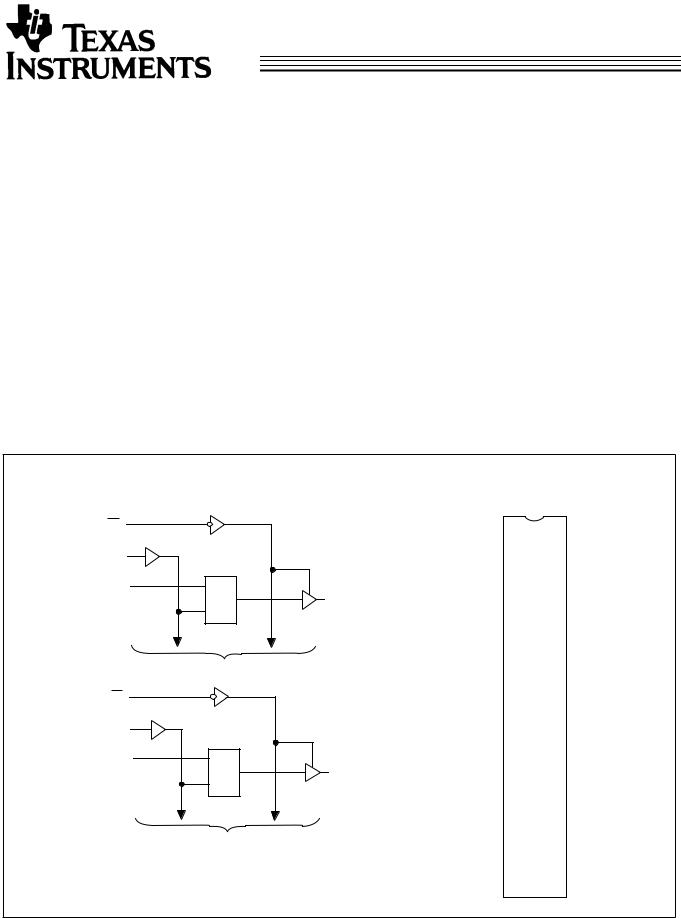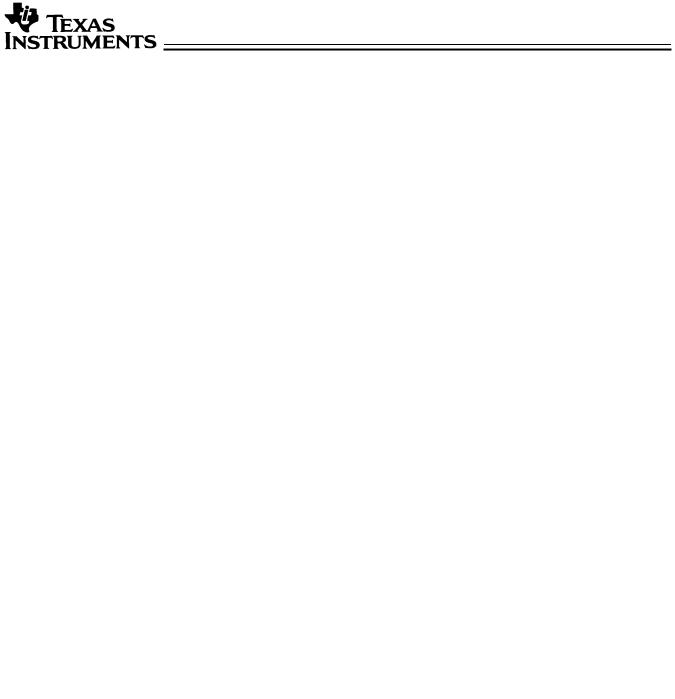Texas Instruments CY74FCT16841CTPVCT, CY74FCT16841CTPVC, CY74FCT16841ATPVC, CY74FCT162841CTPVC, CY74FCT162841CTPAC Datasheet
...
Data sheet acquired from Cypress Semiconductor Corporation. Data sheet modified to remove devices not offered.
CY74FCT16841T
CY74FCT162841T
SCCS067 - July 1994 - Revised March 2000
20-Bit Latches
Features
•FCT-C speed at 5.5 ns (FCT16841T Com’l)
•Power-off disable outputs permits live insertion
•Edge-rate control circuitry for significantly improved noise characteristics
•Typical output skew < 250 ps
•ESD > 2000V
•TSSOP (19.6-mil pitch) and SSOP (25-mil pitch) packages
•Industrial temperature range of−40˚C to +85˚C
•VCC = 5V ± 10%
CY74FCT16841T Features: |
|
|
|
• 64 mA sink current, 32 mA source current |
|
||
• Typical V |
(ground bounce) <1.0V at V |
CC |
= 5V, |
OLP |
|
|
|
TA = 25˚C
CY74FCT162841T Features:
•Balanced 24 mA output drivers
•Reduced system switching noise
• Typical V |
(ground bounce) <0.6V at V |
CC |
= 5V, |
OLP |
|
|
|
TA= 25˚C |
|
|
|
Functional Description
The CY74FCT16841T and CY74FCT162841T are 20-bit D-type latches designed for use in bus applications requiring high speed and low power. These devices can be used as two independent 10-bit latches, or as a single 10-bit latch, or as a single 20-bit latch by connecting the Output Enable (OE) and Latch (LE) inputs. Flow-through pinout and small shrink packaging aid in simplifying board layout. The output buffers are designed with a power-off disable feature to allow live insertion of boards.
The CY74FCT16841T is ideally suited for driving high-capacitance loads and low-impedance backplanes.
The CY74FCT162841T has 24-mA balanced output drivers with current limiting resistors in the outputs. This reduces the need for external terminating resistors and provides for minimal undershoot and reduced ground bounce. The CY74FCT162841T is ideal for driving transmission lines.
Logic Block Diagrams |
Pin Configuration |
SSOP/TSSOP |
|
|
Top View |
1OE
1LE
1D1
D
1Q1
C
TO 9 OTHER CHANNELS
2OE |
2LE |
2D1 |
D |
C |
FCT16841-1
2Q1
TO 9 OTHER CHANNELS
FCT16841-2
|
|
|
|
|
|
|
1OE |
1 |
56 |
1LE |
|||
1Q1 |
|
|
1D1 |
|||
2 |
55 |
|||||
1Q2 |
|
|
1D2 |
|||
3 |
54 |
|||||
|
|
|
|
|||
GND |
4 |
53 |
GND |
|||
|
|
|
1D3 |
|||
1Q3 |
5 |
52 |
||||
|
|
|
||||
1Q4 |
|
|
1D4 |
|||
6 |
51 |
|||||
VCC |
|
|
VCC |
|||
7 |
50 |
|||||
1Q5 |
|
|
1D5 |
|||
8 |
49 |
|||||
1Q6 |
|
|
1D6 |
|||
9 |
48 |
|||||
1Q7 |
|
|
1D7 |
|||
10 |
47 |
|||||
GND |
|
|
GND |
|||
11 |
46 |
|||||
1Q8 |
|
|
1D8 |
|||
12 |
45 |
|||||
1Q9 |
|
|
1D9 |
|||
13 |
44 |
|||||
1Q10 |
|
|
1D10 |
|||
14 |
43 |
|||||
2Q1 |
|
|
2D1 |
|||
15 |
42 |
|||||
|
|
|||||
2Q2 |
16 |
41 |
2D2 |
|||
2Q3 |
|
|
2D3 |
|||
17 |
40 |
|||||
|
|
|||||
GND |
18 |
39 |
GND |
|||
|
|
|
2D4 |
|||
2Q4 |
19 |
38 |
||||
|
|
2D5 |
||||
|
|
Q |
20 |
37 |
||
2 |
5 |
|
|
|
2D6 |
|
|
|
|
||||
2Q6 |
21 |
36 |
||||
|
|
|||||
VCC |
22 |
35 |
VCC |
|||
|
|
|||||
2Q7 |
23 |
34 |
2D7 |
|||
2Q8 |
|
|
2D8 |
|||
24 |
33 |
|||||
|
|
|||||
GND |
25 |
32 |
GND |
|||
2Q9 |
|
|
2D9 |
|||
26 |
31 |
|||||
|
|
|||||
2Q10 |
27 |
30 |
2D10 |
|||
|
|
|||||
2 |
OE |
|
28 |
29 |
2LE |
|
|
|
|
||||
FCT16841-3
Copyright © 2000, Texas Instruments Incorporated

CY74FCT16841T
CY74FCT162841T
Pin Description
|
Name |
Description |
|
|
|
|
|
|
D |
Data Inputs |
|
|
|
|
|
|
LE |
Latch Enable Input (Active HIGH) |
|
|
|
|
|
|
|
|
Output Enable Input (Active LOW) |
|
OE |
||
|
|
|
|
|
O |
Three-State Outputs |
|
|
|
|
|
Function Table[1]
|
Inputs |
|
|
Outputs |
|
|
|
|
|
|
|
D |
LE |
|
|
|
Q |
OE |
|||||
|
|
|
|
|
|
H |
H |
|
L |
H |
|
|
|
|
|
|
|
L |
H |
|
L |
L |
|
|
|
|
|
|
|
X |
L |
|
L |
Q[2] |
|
X |
X |
|
H |
Z |
|
|
|
|
|
|
|
Maximum Ratings[3, 4]
(Above which the useful life may be impaired. For user guidelines, not tested.)
Storage Temperature ...................................... |
−55°C to +125°C |
Ambient Temperature with |
−55°C to +125°C |
Power Applied .................................................. |
|
DC Input Voltage ................................................. |
−0.5V to +7.0V |
DC Output Voltage .............................................. |
−0.5V to +7.0V |
DC Output Current |
−60 to +120 mA |
(Maximum Sink Current/Pin) ........................... |
Power Dissipation .......................................................... |
1.0W |
Static Discharge Voltage............................................ |
>2001V |
(per MIL-STD-883, Method 3015) |
|
Operating Range
|
Ambient |
|
Range |
Temperature |
VCC |
Industrial |
−40°C to +85°C |
5V ± 10% |
|
|
|
Electrical Characteristics Over the Operating Range
Parameter |
Description |
|
|
Test Conditions |
Min. |
Typ.[5] |
Max. |
Unit |
|||
VIH |
Input HIGH Voltage |
Logic HIGH Level |
2.0 |
|
|
V |
|||||
VIL |
Input LOW Voltage |
Logic LOW Level |
|
|
0.8 |
V |
|||||
VH |
Input Hysteresis[6] |
|
|
|
|
|
|
100 |
|
mV |
|
VIK |
Input Clamp Diode Voltage |
VCC=Min., IIN=−18 mA |
|
−0.7 |
−1.2 |
V |
|||||
IIH |
Input HIGH Current |
VCC=Max., VI=VCC |
|
|
±1 |
µA |
|||||
IIL |
Input LOW Current |
VCC=Max., VI=GND |
|
|
±1 |
µA |
|||||
IOZH |
High Impedance Output |
VCC=Max., VOUT=2.7V |
|
|
±1 |
µA |
|||||
|
|
Current (Three-State Output pins) |
|
|
|
|
|
|
|
|
|
|
|
|
|
|
|
|
|||||
IOZL |
High Impedance Output |
VCC=Max., VOUT=0.5V |
|
|
±1 |
µA |
|||||
|
|
Current (Three-State Output pins) |
|
|
|
|
|
|
|
|
|
|
|
|
|
|
|
|
|
|
|
|
|
I |
OS |
Short Circuit Current[7] |
V |
CC |
=Max., V |
|
=GND |
−80 |
−140 |
−200 |
mA |
|
|
|
OUT |
|
|
|
|
|
|||
I |
O |
Output Drive Current[7] |
V |
CC |
=Max., V |
|
=2.5V |
−50 |
|
−180 |
mA |
|
|
|
OUT |
|
|
|
|
|
|||
I |
OFF |
Power-Off Disable |
V |
CC |
=0V, V |
≤4.5V[8] |
|
|
±1 |
µA |
|
|
|
|
OUT |
|
|
|
|
|
|
||
Notes:
1.H = HIGH Voltage Level. L = LOW Voltage Level. X = Don’t Care. Z = HIGH Impedance.
2.Output level before LE HIGH-to-LOW Transition.
3.Operation beyond the limits set forth may impair the useful life of the device. Unless otherwise noted, these limits are over the operating free-air temperature range.
4.Unused inputs must always be connected to an appropriate logic voltage level, preferably either VCC or ground.
5.Typical values are at VCC= 5.0V, TA= +25˚C ambient.
6.This parameter is specified but not tested.
7.Not more than one output should be shorted at a time. Duration of short should not exceed one second. The use of high-speed test apparatus and/or sample and hold techniques are preferable in order to minimize internal chip heating and more accurately reflect operational values. Otherwise prolonged shorting of a high output may raise the chip temperature well above normal and thereby cause invalid readings in other parametric tests. In any sequence of parameter tests, IOS tests should be performed last.
8.Tested at +25˚C.
2
